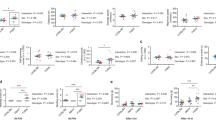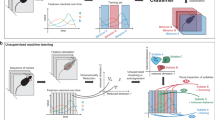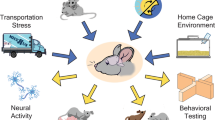Abstract
The elucidation of the human and mouse genomes provides new opportunities for exploring the genetic underpinnings of complex mammalian behaviors. This information also provides new windows into the pathophysiology and treatment of neuropsychiatric diseases. Optimal use of the rapidly escalating numbers of mouse lines engineered for these purposes is hindered, however, by practical and theoretical limitations of common behavioral analyses. New strategies combining automated behavioral monitoring and information technologies are currently under development in both academic and industrial settings. These hold promise, both for improving the throughput of mouse behavioral assessment and for providing new insights into the neurobiology of mammalian behavioral regulation.
This is a preview of subscription content, access via your institution
Access options
Subscribe to this journal
Receive 12 print issues and online access
$209.00 per year
only $17.42 per issue
Buy this article
- Purchase on Springer Link
- Instant access to full article PDF
Prices may be subject to local taxes which are calculated during checkout
Similar content being viewed by others
References
Willner, P. Behavioral models in psychopharmacology. in Behavioral Models in Psychopharmacology: Theoretical, Industrial and Clinical Perspectives (ed. Willner, P.) 3–18 (Cambridge Univ. Press, Cambridge, UK, 1991).
Cryan, J.F., Markou, A. & Lucki, I. Assessing antidepressant activity in rodents: recent developments and future needs. Trends Pharmacol. Sci. 23, 238–245 (2002).
Lister, R.G. Ethologically-based animal models of anxiety disorders. Pharmacol. Ther. 46, 321–340 (1990).
Lister, R.G. The use of a plus-maze to measure anxiety in the mouse. Psychopharmacology 92, 180–185 (1987).
Green, A.R. & Heal, D.J. The effects of drugs on serotonin-mediated behavioural models. in Neuropharmacology of Serotonin (ed. Green, A.R.) 326–365 (Oxford Univ. Press, Oxford, 1985).
Kaakkola, S. & Teravainen, H. Animal models of parkinsonism. Pharmacol. Toxicol. 67, 95–100 (1990).
Gerlai, R. Phenomics: fiction or the future? Trends Neurosci. 25, 506–509 (2002).
Wahlsten, D., Rustay, N.R., Metten, P. & Crabbe, J.C. In search of a better mouse test. Trends Neurosci. 26, 132–136 (2003).
Shekhar, A. et al. Summary of a National Institute of Mental Health workshop: developing animal models of anxiety disorders. Psychopharmacology (Berl.) 157, 327–339 (2001).
Morris, R.G.M., Garrud, P., Rawlins, J.N.P. & O'Keefe, J. Place navigation impaired in rats with hippocampal lesions. Nature 297, 681–683 (1982).
Wehner, J.M., Bowers, B.J. & Paylor, R. The use of null mutant mice to study complex learning and memory processes. Behav. Genet. 26, 301–312 (1996).
D'Hooge, R. & De Deyn, P.P. Applications of the Morris water maze in the study of learning and memory. Brain Res. Brain Res. Rev. 36, 60–90 (2001).
Gerlai, R. Behavioral tests of hippocampal function: simple paradigms complex problems. Behav. Brain Res. 125, 269–277 (2001).
van der Staay, F.J. & Steckler, T. The fallacy of behavioral phenotyping without standardisation. Genes Brain Behav. 1, 9–13 (2002).
McIlwain, K.L., Merriweather, M.Y., Yuva-Paylor, L.A. & Paylor, R. The use of behavioral test batteries: effects of training history. Physiol. Behav. 73, 705–717 (2001).
Rogers, D.C. et al. Behavioral and functional analysis of mouse phenotype: SHIRPA, a proposed protocol for comprehensive phenotype assessment. Mamm. Genome 8, 711–713 (1997).
Voikar, V., Vasar, E. & Rauvala, H. Behavioral alterations induced by repeated testing in C57BL/6J and 129S2/Sv mice: Implications for phenotyping screens. Genes Brain Behav. 3, 27–38 (2004).
Blanchard, R.J. & Blanchard, D.C. Bringing natural behaviors into the laboratory: a tribute to Paul MacLean. Physiol. Behav. 79, 515–524 (2003).
Whishaw, I.Q. & Tomie, J.A. Of mice and mazes: similarities between mice and rats on dry land but not water mazes. Physiol. Behav. 60, 1191–1197 (1996).
Gerlai, R. & Clayton, N.S. Analysing hippocampal function in transgenic mice: an ethological perspective. Trends Neurosci 22, 47–51 (1999).
Dell'Omo, G., Ricceri, L., Wolfer, D.P., Poletaeva, II & Lipp, H. Temporal and spatial adaptation to food restriction in mice under naturalistic conditions. Behav. Brain Res. 115, 1–8 (2000).
Vyssotski, A.L. et al. Long-term monitoring of hippocampus-dependent behavior in naturalistic settings: mutant mice lacking neurotrophin receptor TrkB in the forebrain show spatial learning but impaired behavioral flexibility. Hippocampus 12, 27–38 (2002).
Nestler, E.J. et al. Neurobiology of depression. Neuron 34, 13–25 (2002).
Blanchard, D.C., Griebel, G. & Blanchard Robert, J. The Mouse Defense Test Battery: Pharmacological and behavioral assays for anxiety and panic. Eur. J. Pharmacol. 463, 97–116 (2003).
Scott, M.R., Supattapone, S., Nguyen, H.O., DeArmond, S.J. & Prusiner, S.B. Transgenic models of prion disease. Arch. Virol. 16 (Suppl.), 113–124 (2000).
Owens, T., Wekerle, H. & Antel, J. Genetic models for CNS inflammation. Nat. Med. 7, 161–166 (2001).
Ahmad-Annuar, A., Tabrizi, S.J. & Fisher, E.M. Mouse models as a tool for understanding neurodegenerative diseases. Curr. Opin. Neurol. 16, 451–458 (2003).
Ferrante, R.J. et al. Therapeutic effects of coenzyme Q10 and remacemide in transgenic mouse models of Huntington's disease. J. Neurosci. 22, 1592–1599 (2002).
Bates, G.P. & Hockly, E. Experimental therapeutics in Huntington's disease: are models useful for therapeutic trials? Curr. Opin. Neurol. 16, 465–470 (2003).
Dell'Omo, G. et al. Early behavioural changes in mice infected with BSE and scrapie: automated home cage monitoring reveals prion strain differences. Eur. J. Neurosci. 16, 735–742 (2002).
Nestler, E.J. et al. Preclinical models: status of basic research in depression. Biol. Psychiatry 52, 503–528 (2002).
Tecott, L.H. The genes and brains of mice and men. Am. J. Psychiatry 160, 646–656 (2003).
Koob, G.F., Sanna, P.P. & Bloom, F.E. Neuroscience of addiction. Neuron 21, 467–476 (1998).
Wise, R.A. Drug-activation of brain reward pathways. Drug Alcohol Depend. 51, 13–22 (1998).
Nestler, E.J. Molecular basis of long-term plasticity underlying addiction. Nat. Rev. Neurosci. 2, 119–128 (2001).
Shaham, Y., Erb, S. & Stewart, J. Stress-induced relapse to heroin and cocaine seeking in rats: a review. Brain Res. Brain Res. Rev. 33, 13–33 (2000).
Sutton, M.A. et al. Extinction-induced upregulation in AMPA receptors reduces cocaine-seeking behaviour. Nature 421, 70–75 (2003).
McClearn, G.E. Genetics and alcoholism simulacra. Alcohol Clin. Exp. Res. 3, 255–258 (1979).
Hrabe de Angelis, M.H. et al. Genome-wide, large-scale production of mutant mice by ENU mutagenesis. Nat. Genet. 25, 444–447 (2000).
Hunter, A.J., Nolan, P.M. & Brown, S.D. Towards new models of disease and physiology in the neurosciences: the role of induced and naturally occurring mutations. Hum. Mol. Genet. 9, 893–900 (2000).
Brunner, D., Nestler, E. & Leahy, E. In need of high-throughput behavioral systems. Drug Discov. Today 7, S107–S112 (2002).
Goulding, E.H., Juneja, P., Wade, J. & Tecott, L.H. Quantitative analysis of ingestive behavior pattern in 5-HT2c receptor, obese, and agouti mutant mice. Appetite 39, 78 (2002).
Paigen, K. & Eppig, J.T. A mouse phenome project. Mamm. Genome 11, 715–717 (2000).
Author information
Authors and Affiliations
Corresponding author
Ethics declarations
Competing interests
E.J.N. reports financial interests in PsychoGenics, Inc., a biotech company invested in development of high-throughput behavioral assays.
Rights and permissions
About this article
Cite this article
Tecott, L., Nestler, E. Neurobehavioral assessment in the information age. Nat Neurosci 7, 462–466 (2004). https://doi.org/10.1038/nn1225
Published:
Issue Date:
DOI: https://doi.org/10.1038/nn1225
This article is cited by
-
EDDSN-MRT: multiple rodent tracking based on ear detection and dual siamese network for rodent social behavior analysis
BMC Neuroscience (2023)
-
Development of behavioral patterns in young C57BL/6J mice: a home cage-based study
Scientific Reports (2022)
-
Behavioral models in psychopathology: epistemic and semantic considerations
Behavioral and Brain Functions (2019)
-
Motion mapping in humans as a biomarker for psychiatric disorders
Neuropsychopharmacology (2019)
-
Real-time analysis of the behaviour of groups of mice via a depth-sensing camera and machine learning
Nature Biomedical Engineering (2019)



